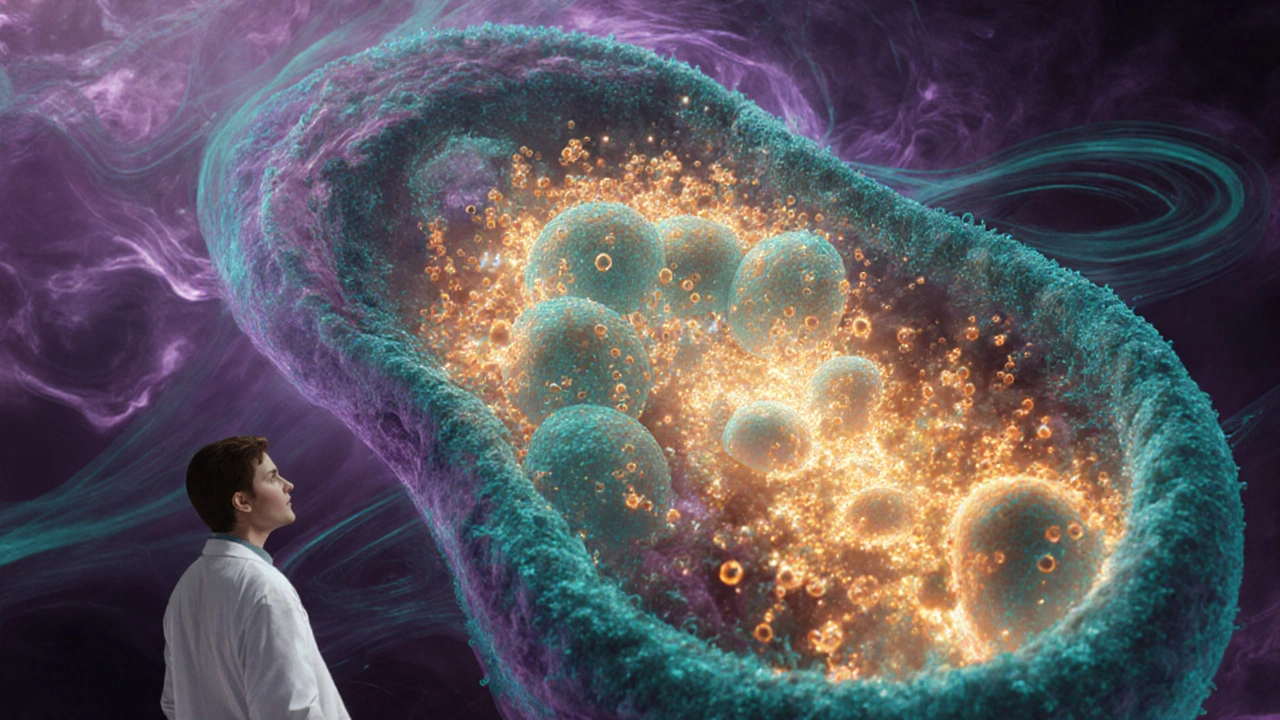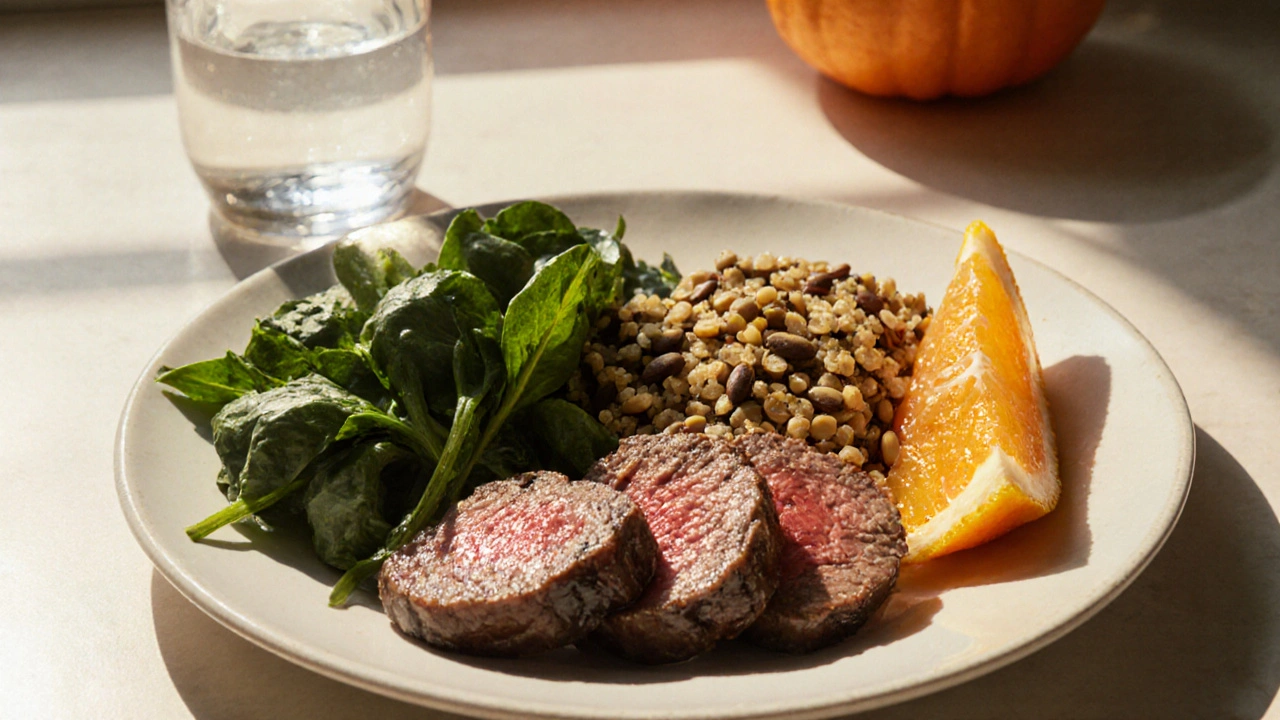iron is more than a blood‑building mineral - it powers every cell’s engine and keeps you from feeling drained.
- Iron is a key component of the electron transport chain that creates ATP.
- Without enough iron, hemoglobin can’t carry oxygen, leading to anemia.
- Mitochondria use iron‑sulfur clusters to convert food into usable energy.
- Both dietary choices and supplementation affect iron status.
- Monitoring ferritin and hemoglobin gives early warning of deficiency.
What Is Iron and Why Does the Body Need It?
When we talk about Iron is a trace mineral that participates in redox reactions, helps make hemoglobin, and forms essential cofactors in enzymes, we’re describing a tiny atom with a huge impact. In its ferrous (Fe²⁺) and ferric (Fe³⁺) forms, iron shuttles electrons, enabling chemical reactions that release energy from glucose and fatty acids. The body contains about 3‑4 grams of iron, most of it locked inside red blood cells and muscle mitochondria.
Iron’s Role in Cellular Energy Production
The powerhouse of the cell - the Mitochondria are organelles that generate ATP through oxidative phosphorylation. Inside the inner mitochondrial membrane sits the electron transport chain (ETC), a series of protein complexes that pump protons to create a gradient used by ATP synthase. Two of these complexes - Complex I (NADH dehydrogenase) and Complex III (cytochrome bc1) - rely on iron‑sulfur (Fe‑S) clusters and heme groups to transfer electrons.
Without sufficient iron, the Fe‑S clusters can’t form properly, causing a bottleneck in the ETC. The result? Less ATP, slower metabolism, and that familiar fatigue. Studies in athletes show that iron‑replete individuals have up to 15% higher VO₂ max, underscoring iron’s direct link to endurance.
Iron and the Hemoglobin Oxygen‑Transport System
Another cornerstone is Hemoglobin is a protein in red blood cells that binds oxygen via an iron‑containing heme group. Each hemoglobin molecule holds four heme groups, each with an iron atom at its center. When iron is scarce, the body makes fewer hemoglobin molecules, lowering the blood’s oxygen‑carrying capacity.
Low oxygen delivery forces cells to rely more on anaerobic glycolysis, producing less ATP and more lactic acid - another reason why iron deficiency feels like a constant “muscle burn.” This cascade explains why iron deficiency is the leading cause of anemia worldwide.
Ferritin, Transferrin, and the Body’s Iron‑Storage System
To keep iron available yet prevent its toxic free‑radical form, the body stores it in Ferritin is a protein complex that safely hoards iron inside cells, releasing it when needed. Serum ferritin levels reflect the total iron reserve. Meanwhile, Transferrin is a blood‑borne carrier protein that transports iron to cells via transferrin receptors.
When ferritin drops below 30µg/L, the body’s iron pool is depleted, often before hemoglobin levels fall. Monitoring both ferritin and hemoglobin gives a fuller picture of iron status, allowing early intervention before full‑blown anemia sets in.
Dietary Sources: Heme vs. Non‑Heme Iron
| Type | Food Examples | Average Absorption Rate |
|---|---|---|
| Heme Iron | Beef liver, chicken thigh, tuna, pork | 15‑35% |
| Non‑Heme Iron | Spinach, lentils, fortified cereals, beans | 2‑20% |
Heme iron, found in animal products, is absorbed via a separate transporter that bypasses many dietary inhibitors. Non‑heme iron, the plant‑based kind, is more susceptible to phytates, polyphenols, and calcium, which can block absorption. Pairing non‑heme sources with vitaminC‑rich foods (like citrus or bell peppers) can boost uptake by up to 4‑fold.

Supplementation: When Food Isn’t Enough
Iron supplements come in several forms: ferrous sulfate, ferrous gluconate, and ferrous fumarate. Ferrous sulfate delivers the highest elemental iron (about 20% of the tablet weight) but also carries a higher risk of gastrointestinal upset. For those with sensitive stomachs, ferrous gluconate (10% elemental) or slow‑release formulations can be gentler.
A common mistake is taking iron on an empty stomach to improve absorption, only to experience nausea. The best practice is to consume a small amount of vitaminC (like a glass of orange juice) with the dose, and if needed, a snack later to reduce side effects. Adults typically need 8mg (men) to 18mg (women of child‑bearing age) of elemental iron daily; higher doses are prescribed for clinically diagnosed deficiency.
Preventing Anemia: Lifestyle Tips and Red Flags
Beyond diet, several lifestyle factors influence iron balance:
- Regular exercise: Increases red blood cell turnover and stimulates iron mobilization.
- Limit Calcium supplements as they compete with iron for absorption.
- Avoid excessive coffee or tea during meals - the polyphenols bind iron.
- Women with heavy menstrual bleeding should track iron intake closely.
Early symptoms of iron deficiency include lingering fatigue, shortness of breath on mild exertion, and cravings for ice or non‑nutritive substances (pica). If you notice these signs, a simple blood test for hemoglobin, ferritin, and transferrin saturation can confirm the diagnosis.
Quick Checklist: Keeping Your Iron Levels Optimal
- Include a source of heme iron at least twice a week.
- Combine every non‑heme iron meal with a vitaminC source.
- Limit coffee/tea intake to after meals.
- Check ferritin annually if you’re a menstruating woman, athlete, or vegetarian.
- Consider a low‑dose iron supplement if ferritin stays below 30µg/L.
Common Misconceptions About Iron
Many think “more iron is always better.” In reality, excess iron can catalyze free‑radical formation, damaging cells and increasing risk of conditions like hemochromatosis. That’s why self‑prescribing high‑dose supplements without testing can be harmful.
Another myth: “Plant‑based diets can’t meet iron needs.” With strategic food pairing and occasional fortified foods, vegans can maintain healthy ferritin levels. Monitoring is key, not avoidance.
Frequently Asked Questions
How quickly can iron supplements raise ferritin levels?
Most people see a 5‑10µg/L rise in ferritin after 4‑6 weeks of consistent supplementation, assuming no ongoing blood loss.
Can I get enough iron from a vegetarian diet?
Yes, but you must pair iron‑rich plant foods with vitaminC, limit inhibitors, and possibly use a fortified cereal or mild supplement.
Why do I feel tired even after a good night’s sleep?
If your diet lacks iron, your mitochondria can’t produce enough ATP, leaving you lethargic despite adequate rest.
Is it safe to take iron with calcium supplements?
Calcium competes with iron for absorption, so it’s best to space them out by at least two hours.
What lab values indicate iron deficiency?
Ferritin below 30µg/L, transferrin saturation under 20%, and hemoglobin under 12g/dL for women (13g/dL for men) are typical thresholds.

Iron absorption can be a real minefield; phytates in beans, polyphenols in tea, and even calcium pills act like traffic lights, telling the gut to slow down uptake.
Pairing non‑heme sources with a squeeze of lemon or a handful of strawberries creates a vitamin C‑boosted tunnel, often quadrupling the amount that slips into the bloodstream.
Try cooking leafy greens with a dash of olive oil – the fat helps pull the iron into the cells while the heat breaks down some of the inhibitors.
And remember, spacing coffee or tea at least an hour away from meals is a simple trick to keep your mitochondria humming.
Consider iron not merely as a mineral, but as a silent conductor orchestrating the symphony of cellular respiration; without its baton, the electrons wander, the ATP chorus falters, and the organism sighs in fatigue, a fate perhaps symbolic of our modern disconnection from elemental roots.
Honestly, if you keep ignorng iron, you’re just asking for fatigue.
For folks who rely on plant‑based meals, think about stacking lentils with red pepper and a splash of orange juice; the vitamin C acts like an iron‑friendly bridge, letting the non‑heme iron cross the intestinal barrier more efficiently.
Adding a few nuts or seeds sprinkled on top contributes healthy fats, which can also aid in the microscopic transport of iron particles.
Don’t forget fermented foods like tempeh – they can reduce phytate levels, further clearing the path for iron uptake.
When you look at the electron transport chain, iron‑sulfur clusters function as the critical relay stations that shuttle electrons from NADH to coenzyme Q, and any deficiency throws a wrench into this high‑speed conveyer belt.
First, without adequate Fe²⁺, Complex I experiences a reduced redox potential, meaning fewer protons are pumped across the inner mitochondrial membrane.
Second, the downstream effect is a lower electrochemical gradient, which directly translates to diminished ATP synthase activity.
This biochemical bottleneck manifests clinically as a drop in VO₂ max, something that endurance athletes notice within weeks of sub‑optimal iron intake.
Laboratory data consistently show that ferritin levels below 30 µg/L correlate with a 10‑15 % reduction in maximal oxygen uptake.
Moreover, iron deficiency triggers a compensatory increase in glycolytic flux, leading to elevated lactate production even at modest workloads.
The resulting metabolic acidosis can impair muscle contractility and delay recovery after training sessions.
From a therapeutic standpoint, oral ferrous sulfate provides roughly 20 % elemental iron per tablet, but the gastrointestinal mucosa can become irritated, reducing adherence.
Alternatively, slow‑release ferrous gluconate offers a gentler profile, albeit with a lower elemental payload, making it suitable for individuals with sensitive stomachs.
Timing of ingestion matters: consuming iron alongside a vitamin C source-think a quarter‑glass of orange juice-enhances solubility and uptake via the DMT1 transporter.
Avoiding concurrent calcium supplementation or polyphenol‑rich beverages like coffee can prevent competitive inhibition at the brush border.
In practice, a 4‑week regimen of 60 mg elemental iron daily can raise serum ferritin by 5‑10 µg/L, assuming no ongoing blood loss.
Monitoring both hemoglobin and ferritin every 6‑8 weeks allows clinicians to adjust dosing before anemia becomes overt.
Remember, excess iron is not benign; free iron catalyzes Fenton reactions, generating reactive oxygen species that can damage cellular membranes.
Thus, individualized dosing based on lab values, dietary patterns, and lifestyle factors remains the gold standard for optimizing cellular energy production. 😊
It’s encouraging to see the emphasis on routine testing; regular checks of ferritin and transferrin saturation can catch a decline before hemoglobin dips, allowing early intervention.
For individuals with menstrual blood loss exceeding 80 mL per cycle, supplementing with 18 mg elemental iron alongside a vitamin C‑rich snack often restores stores within two months.
Athletes should also consider integrating beetroot juice, which not only supplies nitrates for vasodilation but contains modest iron that contributes to overall intake.
One might wonder whether the pharmaceutical industry isn’t simply marketing iron pills as a panacea, pushing us to swallow tablets while the real solution lies in whole foods, soil health, and-dare I say-skeptical scrutiny of “clinical guidelines” that often ignore individual variability; after all, not every low ferritin reading mandates a synthetic supplement, especially when dietary diversity can achieve comparable outcomes.
Only a fool would ignore the lethal cascade of iron deficiency.
While the article is thorough, it could benefit from a concise summary table distinguishing heme from non‑heme sources, as the current format may overwhelm readers seeking quick reference.
Iron is needed for energy. Too much iron can hurt. Check levels before taking pills.
Great breakdown! I’ve seen clients who added a small orange juice serving with their iron tablets and reported less stomach upset 😊. Keep the iron steady and the performance will follow.
Love the practical tips! I always schedule my morning coffee after breakfast now, and the difference in my afternoon energy is noticeable. Thanks for the reminder!
Those food combos are gold! 🌱🥗 Adding lemon to spinach salads has become my go‑to move, and I feel less sluggish during work breaks. 🙌
The metaphor really hits home; viewing iron as a conductor makes the biochemical dance easier to picture, and it underscores why a disruption feels so profound.
Indeed, the analogy aligns with the principle that without a proper catalyst, the metabolic orchestra loses its rhythm; thus, maintaining optimal iron levels is akin to keeping the conductor’s baton firmly in hand, ensuring each section performs in harmony.
Spot on about regular testing; I’d add that athletes should also track their resting heart rate, as a sudden rise can hint at insufficient oxygen transport linked to low iron.